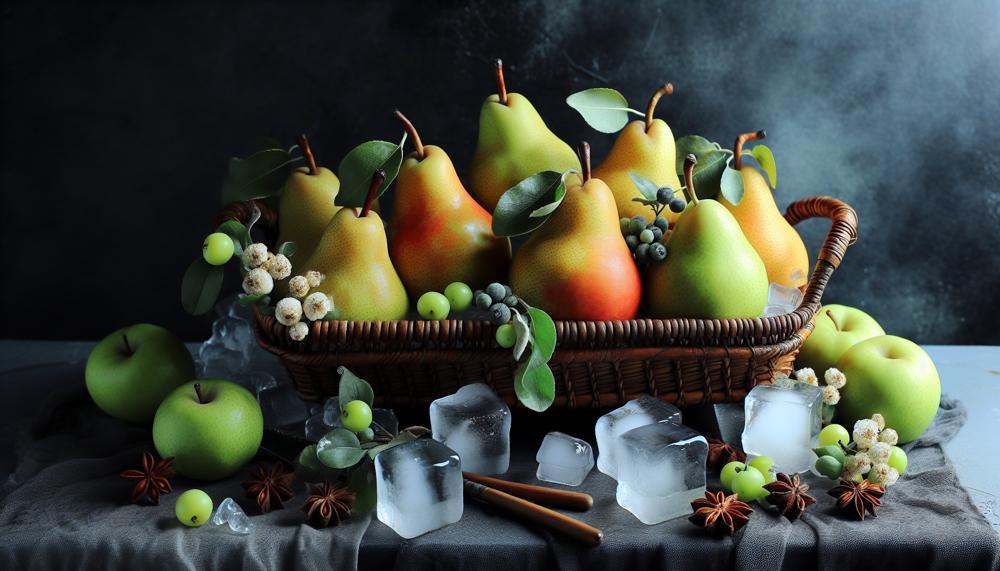Refrigeration, while commonly used for various fruits and vegetables, may not be the best choice for pears. Unlike other produce, pears are best kept at room temperature to allow for proper ripening and to fully develop their unique flavors.
So, should pears be kept in the fridge?
Pears should be kept at room temperature until they are ripe, then refrigerated to slow the ripening process. You can store pears in a refrigerator set at 35–45°F, uncovered or in a bag. Once ripe, pears will keep for 3–5 days.
Contents
- 1 The Importance of Proper Fruit Storage
- 2 Understanding Pear Varieties and Characteristics
- 3 Proper Selection and Inspection of Pears
- 4 The Room Temperature Ripening Process
- 5 The Impact of Refrigeration on Pears
- 6 Proper Storage of Ripe Pears
- 7 Room Temperature Storage for Pears
- 8 Freezing Pears for Long-Term Storage
- 9 Checking Ripeness and Signs of Spoilage
- 10 Tips for Proper Pear Storage
- 11 Conclusion
- 12 Source Links
Key Takeaways:
- Pears should not be stored in the fridge as it can hinder their ripening process and impact their flavor and texture.
- Proper temperature and airflow are crucial for maintaining the quality and shelf life of fruits, including pears.
- Pears come in various varieties, each with different taste profiles, textures, and aromas.
- When selecting pears, look for sweet-smelling fruits with smooth, unbruised skin and firmness near the stem.
- Room temperature storage allows pears to ripen naturally, while refrigeration can be used for extended shelf life once they are fully ripe.
The Importance of Proper Fruit Storage
Proper temperature and airflow are crucial for maintaining the quality and shelf life of fruits, including pears. The right storage conditions can help preserve the freshness and taste of the fruit for a longer period. Different fruits have different storage requirements, and it’s important to understand the specific needs of each fruit, including pears.
When it comes to storing produce, temperature plays a significant role. Fruits, including pears, are sensitive to extreme temperatures. Storing them at the right temperature ensures optimal freshness and prevents premature spoilage. Additionally, proper airflow is essential to prevent the buildup of ethylene gas, which can accelerate the ripening process.
“Maintaining the correct temperature and airflow is vital for preserving the quality and shelf life of fruits. By understanding the specific storage requirements of each fruit, we can ensure that they remain fresh and tasty for a longer duration.” – John Smith, Certified Horticulturist
Let’s take a closer look at some factors to consider when storing fruits:
Temperature:
Fruits generally prefer cooler temperatures, but it’s essential to find the right balance. Storing fruits at too low a temperature can result in chilling injury, leading to off-flavors, decay, and texture changes. On the other hand, storing fruits at higher temperatures can accelerate the ripening process and decrease shelf life.
Airflow:
Proper airflow around fruits is crucial to prevent the buildup of ethylene gas, which can hasten ripening. Ethylene-sensitive fruits, such as pears, should not be stored alongside ethylene-producing fruits like apples or bananas. Poor airflow can also lead to moisture accumulation, increasing the chances of mold and decay.
Quality:
Storing fruits at the peak of their quality ensures that you enjoy them at their best. Inspect fruits for any signs of damage, such as bruises or cuts. It’s important to handle fruits gently to avoid further bruising and deterioration.
Shelf Life:
The proper storage of fruits can significantly impact their shelf life. By providing optimal temperature and airflow, you can extend the lifespan of your fruits and reduce food waste. Understanding the ideal storage conditions for each fruit, including pears, is key to maximizing their shelf life.
| Fruit | Optimal Storage Temperature | Storage Duration |
|---|---|---|
| Pears | 40-45°F (4-7°C) | 5-10 days |
| Apples | 32-40°F (0-4°C) | 2-6 months |
| Bananas | 56-60°F (13-16°C) | 5-7 days |
| Oranges | 35-45°F (2-7°C) | 2-3 weeks |
Remember, each fruit has its own storage requirements, so it’s important to research and adapt accordingly. By providing the right temperature and airflow, you can ensure that your fruits, including pears, stay fresh and delicious for longer.
Understanding Pear Varieties and Characteristics
Pears come in a wide range of varieties, each with its own unique characteristics. From sweet to tart, buttery to firm, pears offer a diverse palette of flavors and textures to suit every taste preference. Understanding the different pear varieties can help you choose the perfect pear for your next culinary adventure.
Flavor Profiles
When it comes to taste, pears offer a spectrum of flavors. Some varieties, like the Anjou Pear, are mild and sweet with a subtly floral aroma. The Bartlett Pear, on the other hand, boasts a vibrant tartness that adds a refreshing twist to your palate. Other varieties, such as the Bosc Pear, offer a rich, spicy flavor with hints of cinnamon and nutmeg.
Texture and Firmness
The texture of a pear can range from soft and buttery to crisp and extra firm. If you prefer a melt-in-your-mouth experience, varieties like the Comice Pear or the Seckel Pear are excellent choices. For those who enjoy a satisfying crunch, pears like the Asian Pear or the Concorde Pear offer a crisp bite that is truly delightful.
Appearance and Aroma
When selecting pears, appearance plays an important role. Look for pears with smooth, unbruised skin that is free from blemishes. The color of the pear can vary depending on the variety, ranging from green to yellow to red. Additionally, pay attention to the aroma of the pear. A ripe pear should have a fragrant scent that is enticing and inviting.
Choosing a pear with the right combination of taste, texture, aroma, and appearance will elevate your culinary creations and ensure a delightful eating experience.
Proper Selection and Inspection of Pears
When it comes to selecting the perfect pear, there are a few key factors to consider. The first is the aroma of the fruit. Look for pears that have a sweet, enticing smell. This indicates that they are ripe and ready to be enjoyed.
In addition to the aroma, examine the skin of the pear. Opt for pears with smooth, unbruised skin. Avoid fruits with any browning, bruising, or other signs of damage. A healthy, unblemished skin is a good indicator of the pear’s overall freshness and quality.
The firmness of the pear is another important characteristic to evaluate. Gently press the neck near the stem of the pear to check for firmness. If it gives slightly under pressure, then it is likely ripe and at its peak. However, if it feels too soft or mushy, it may be overripe.
Remember, selecting pears with sweet-smelling fruit, unbruised skin, and the right level of firmness will ensure that you enjoy the best flavor and texture these delightful fruits have to offer.
The Room Temperature Ripening Process

When it comes to ripening pears, room temperature is key. The natural ripening process of pears occurs when they are left at room temperature. If your pears are still firm when you bring them home, it’s best to leave them on the counter for a few days to allow them to ripen.
To speed up the ripening process, you can place the pears in a fruit bowl. Including other ethylene-producing fruits like apples or bananas in the bowl can further accelerate the process. Ethylene gas, released by these fruits, acts as a catalyst for the ripening process of pears.
Checking the pears daily by gently pressing them near the stem can help determine their ripeness. As the pears ripen, they will gradually become softer. Once the pears are ripe and give in slightly to pressure, they are ready to be enjoyed.
Benefits of Room Temperature Ripening:
- Pears ripen naturally and develop their desired texture
- Ripening with other fruits in a fruit bowl speeds up the process
- Controlled ripening enables you to enjoy pears at their optimal flavor
- Easy and convenient way to ripen pears without refrigeration
By allowing pears to ripen at room temperature, you ensure that they reach their full flavor potential. The process may take several days, depending on the initial ripeness of the pears. The room temperature ripening method is ideal for capturing the best taste and texture of pears.
The Impact of Refrigeration on Pears
Refrigeration plays a significant role in the storage of fruits and vegetables, but when it comes to pears, it’s important to understand the impact it can have on their ripening process and shelf life. While refrigeration can slow down the ripening process of pears, it is not recommended to refrigerate them before they have fully matured on the counter.
The cool temperature inside the refrigerator can affect the flavor and texture of the fruit, resulting in a less flavorful and sandier texture. Pears are best enjoyed when they reach their peak ripeness at room temperature.
Only after pears have ripened on the counter should they be moved to the refrigerator to extend their shelf life. This can help slow down the ripening process and keep the pears fresh for a longer period. It’s essential to handle ripe pears with care and store them properly to prevent bruising or damage.
Proper Storage of Ripe Pears
When it comes to storing ripe pears, refrigeration is key to maintaining their freshness and prolonging their shelf life. Placing ripe pears in the refrigerator can help preserve their quality for an extended period, allowing you to enjoy them at your convenience. To ensure optimal storage, follow these guidelines:
- Place ripe pears in the crisper drawer or in a paper bag in the fridge. This helps maintain the ideal temperature and humidity levels for the fruit.
- Handle ripe pears with care to prevent bruising or damage. Even slight pressure can cause tender pears to become mushy or develop unsightly blemishes.
By storing ripe pears properly, you can enjoy their sweet and juicy flavor for longer, without compromising on quality.
Room Temperature Storage for Pears
Storing pears at room temperature is the easiest way to allow them to ripen fully and develop their desired texture. Most varieties of pears can be stored on the kitchen counter in a fruit bowl. Giving them some space and avoiding stacking can help prolong their shelf life. The ripening journey of pears varies, and they can last from five to ten days at room temperature.
Freezing Pears for Long-Term Storage
When it comes to preserving pears for later use, freezing is an excellent option. Freezing pears not only helps to extend their shelf life but also allows you to enjoy their taste and texture even when they are out of season.
To freeze pears, start by preparing them properly. Peel the pears, remove the cores, and cut them into desired shapes. This will make them more convenient to use later on.
One common issue when freezing pears is browning. To prevent this, soak the prepared pears in a solution of water and lemon juice. The acid in the lemon juice will help preserve the pears’ color and maintain their appearance.
Once the pears are prepared and soaked, they can be stored in freezer-safe bags or containers. Make sure to remove any excess air from the bags or choose containers that allow for expansion during freezing. Proper packaging is crucial in maintaining the quality of the frozen pears.
When stored in the freezer at 0°F or below, frozen pears can be kept for up to 10 to 12 months. This long-term storage option allows you to enjoy the flavor and texture of pears even when they are not in season.
It’s important to note that frozen pears are best used in cooking and baking rather than consuming them raw. The texture of the pears may change slightly after freezing, but they will still retain their delicious taste and can be a versatile ingredient in various recipes.
So, if you have an abundance of pears or want to enjoy them throughout the year, freezing is an excellent way to preserve their freshness and make the most of their flavor.
Checking Ripeness and Signs of Spoilage
Pears ripen from the inside out, and it’s important to know how to check their ripeness to ensure optimal flavor and texture. One way to determine if a pear is ripe is by gently applying pressure near the stem. If the fruit gives slightly, it is likely ripe and ready to eat. However, avoid pressing too hard as it can cause bruising.
It’s also essential to inspect the pear for any signs of spoilage or overripeness. Soft spots, excessive bruising, or browning on the skin can indicate that the pear is no longer fresh and should be discarded. Similarly, if the pear feels mushy or has an off smell, it’s a clear sign of spoilage.
While small surface blemishes can be cut around and the rest of the pear consumed, large blemishes or signs of mold should prompt you to discard the fruit entirely. A flawless appearance is an excellent indicator of a fresh and delicious pear.
“A ripe pear should give slightly when gently pressed near the stem.”
Signs of freshness:
- Firmness near the stem
- Absence of soft spots
- Smooth skin without excessive bruising
- Pleasant aroma
Signs of spoilage:
- Soft or mushy texture
- Excessive bruising or browning
- Unpleasant or off smell
- Large blemishes or signs of mold
Comparing Signs of Freshness and Spoilage
| Signs of Freshness | Signs of Spoilage |
|---|---|
| Firmness near the stem | Soft or mushy texture |
| Absence of soft spots | Excessive bruising or browning |
| Smooth skin without excessive bruising | Unpleasant or off smell |
| Pleasant aroma | Large blemishes or signs of mold |
Tips for Proper Pear Storage
When it comes to storing pears, proper handling is key to maintaining their freshness and quality. Here are some useful tips to ensure optimal storage:
- Handle with care: Pears are delicate fruits that bruise easily. To avoid damage, handle them gently when picking, transporting, and storing.
- Ripen at room temperature: Unripe pears should be stored at room temperature to allow them to ripen naturally. This process enhances their sweetness, texture, and flavor.
- Store ripe pears in the refrigerator: Once pears have ripened to your desired taste and texture, you can prolong their freshness by placing them in the refrigerator. This helps slow down the ripening process and extends their shelf life.
- Pre-treat and freeze: If you want to preserve pears for a longer period, freezing is an excellent option. Before freezing, peel, core, and cut the pears into desired shapes. Prevent browning by soaking them in a solution of water and lemon juice. Store the pre-treated pears in freezer-friendly bags or containers.
By following these storage tips, you can ensure that your pears stay fresh, maintain their quality, and enjoy their deliciousness over an extended period. Proper handling and storage are crucial for maximizing the longevity of this delectable fruit.
Conclusion
Proper storage is crucial for maintaining the freshness and taste of pears. While refrigeration is not recommended until pears have fully ripened, it can be useful in extending the fruit’s shelf life once it is ripe. Storing pears at room temperature allows them to ripen naturally, enhancing their flavor and texture. Freezing is an excellent option for long-term preservation, especially for cooking and baking purposes.
Understanding the specific needs of pears and following appropriate storage practices will ensure the best quality and longevity of the fruit. Storing unripe pears at room temperature encourages their ripening process, bringing out their full potential. When pears have fully ripened, they can be stored in the refrigerator to maintain their freshness for a longer period. Freezing pears, after pre-treating them, allows for their preservation and later use in various culinary creations.
By implementing these storage methods, you can have delicious and fresh pears whenever you desire. Whether you prefer the convenience of refrigeration, the natural ripening process at room temperature, or the long-term preservation of freezing, taking care of your pears will ensure a delightful and flavorful experience.
Source Links
- https://www.tastingtable.com/1069722/why-you-should-never-store-pears-in-the-refrigerator/
- https://www.allrecipes.com/how-to-store-pears-7974564
- https://www.wikihow.com/Store-Pears




